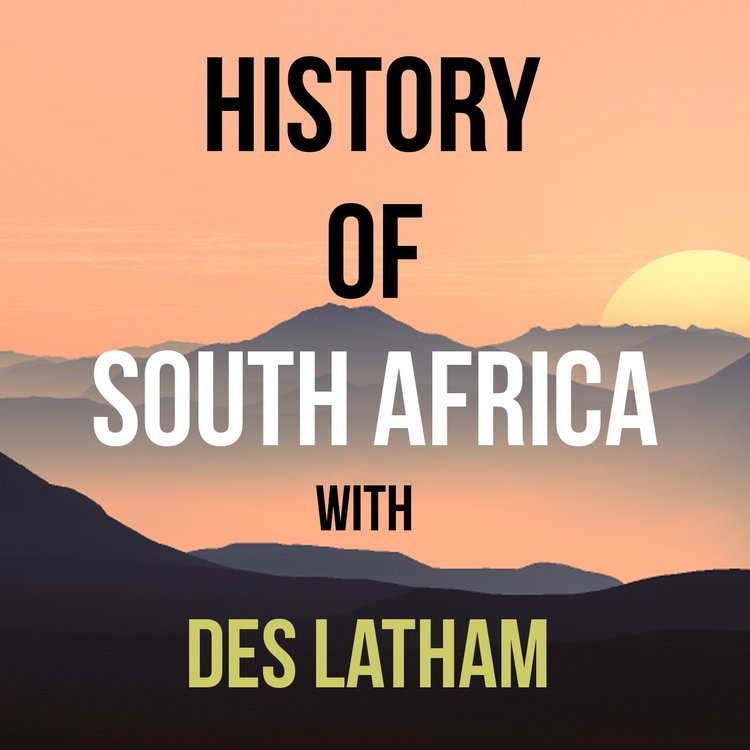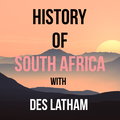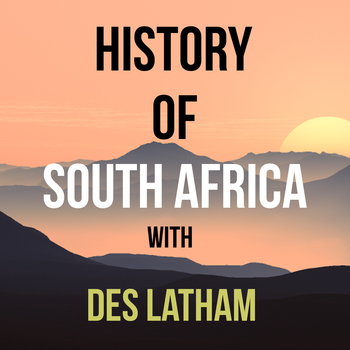
Episode 182 - The English Column’s Desperate March to Fort White
Loading player...
Welcome to the History of South Africa podcast with me your host, Des Latham, this is episode 182.
182 is a triangular number meaning it can be arranged in an equilateral triangle — specifically it is the 13th triangle number because 13x4 Divided by 2 is 182.
And it’s a death triangle that the British were facing now - facing amaXhosa prophecy, a blazing hot environment not conducive to their warfare, and the amaXhosa chiefs who were stacking up against the invaders.
When we left off, the British column under Lieutenant Colonel George Mackinnon was trying to make it back to Fort White having been whipped by the amaXhosa in the Boma Pass. It’s important to note that all 12 British killed in that ambush were shot.
Previously in the first seven Frontier Wars, most soldiers were stabbed by amaXhosa wielding assegais, but now the boot was on the other foot. And yet in the coming months of war, the Xhosa would use their trusty assegai’s to good effect as you’re going to hear.
It was Boxing Day 1850, a year in which the transportation of British convicts to Western Australia had begun just as it was being phased out in other parts of that territory. In June 1850 Former Twice-Served British Prime Minister Sir Robert Peel fell off his horse and died.
Mayer Lehman sailed from Germany to join his two brothers in the United States, who were running a dry-goods business, a pre-cursor to the doomed Lehman Brothers bank which collapsed in 2007 and took the world’s economy with it.
Also in the United States, Edward Ralph May delivered a speech to the Indiana legislature where he called for African-Americans to be given the right to vote. This was a period when slavery was still legal in the U.S., ten years before the civil War.
In southern Africa, Mackinnon’s men had been shot at through Christmas by Sandile’s warriors who were imbued with Prophet Mlanjeni’s magic - and now the troops were trying to escape what looked like certain doom. They’d bivouacked overnight at the Uniondale mission station at Keiskamma Hoek.
It hadn’t helped that Mackinnon stuck to his original orders like a limpet to a rock. Governor Sir Harry Smith had ordered that the men should march with firearms unloaded to avoid any accidents, and despite the fact that a large army of amaXhosa were now tailing the British as they were force marched to Fort White, the muskets remained unloaded.
In nearby Woburnin for example, homes had been built at Ngqika’s warrior son Thyali’s grave. As you’ve heard the ex-British soldiers living there had opened up and desecrated the grave. For the Ngqika line of the Rharhabe - this military village would be their first main target.
The amaNgqika had watched the vets till their land, they lived cheek by jowel. The land that had recently been their forefathers.
The little river between Woburn and the amaNgqika was easy to cross except when in full spate, and a large amaXhosa army crossed the river on Christmas Day 1850, and laid waste to Woburn which they attacked at nine in the morning.
Sixteen ex-soldiers farmed here some with families, and they were overrun in less than an hour - the women and children spared, the men speared or shot.
The nearby military village of Auckland was attacked at two in the afternoon, it lay in a a bowl at the head of the Thyumie River valley and this was a trap from which none of the soldiers would escape. There was no clear view down into the valley which meant they had no idea what was taking place they could not see the smoke from Woburn and the little village of Juanasberg.
When a Khoekhoe woman struggled up the path on Christmas morning and told the inhabitants of Auckland she had spotted smoke from the other villages, she was ignored.
Across the other side of the Amatola mountains, the British troops who’d managed to make it out of Boma Passthen marched off from Keiskamma hoek heading to Fort White, were suffering in the mid-summer heat.
182 is a triangular number meaning it can be arranged in an equilateral triangle — specifically it is the 13th triangle number because 13x4 Divided by 2 is 182.
And it’s a death triangle that the British were facing now - facing amaXhosa prophecy, a blazing hot environment not conducive to their warfare, and the amaXhosa chiefs who were stacking up against the invaders.
When we left off, the British column under Lieutenant Colonel George Mackinnon was trying to make it back to Fort White having been whipped by the amaXhosa in the Boma Pass. It’s important to note that all 12 British killed in that ambush were shot.
Previously in the first seven Frontier Wars, most soldiers were stabbed by amaXhosa wielding assegais, but now the boot was on the other foot. And yet in the coming months of war, the Xhosa would use their trusty assegai’s to good effect as you’re going to hear.
It was Boxing Day 1850, a year in which the transportation of British convicts to Western Australia had begun just as it was being phased out in other parts of that territory. In June 1850 Former Twice-Served British Prime Minister Sir Robert Peel fell off his horse and died.
Mayer Lehman sailed from Germany to join his two brothers in the United States, who were running a dry-goods business, a pre-cursor to the doomed Lehman Brothers bank which collapsed in 2007 and took the world’s economy with it.
Also in the United States, Edward Ralph May delivered a speech to the Indiana legislature where he called for African-Americans to be given the right to vote. This was a period when slavery was still legal in the U.S., ten years before the civil War.
In southern Africa, Mackinnon’s men had been shot at through Christmas by Sandile’s warriors who were imbued with Prophet Mlanjeni’s magic - and now the troops were trying to escape what looked like certain doom. They’d bivouacked overnight at the Uniondale mission station at Keiskamma Hoek.
It hadn’t helped that Mackinnon stuck to his original orders like a limpet to a rock. Governor Sir Harry Smith had ordered that the men should march with firearms unloaded to avoid any accidents, and despite the fact that a large army of amaXhosa were now tailing the British as they were force marched to Fort White, the muskets remained unloaded.
In nearby Woburnin for example, homes had been built at Ngqika’s warrior son Thyali’s grave. As you’ve heard the ex-British soldiers living there had opened up and desecrated the grave. For the Ngqika line of the Rharhabe - this military village would be their first main target.
The amaNgqika had watched the vets till their land, they lived cheek by jowel. The land that had recently been their forefathers.
The little river between Woburn and the amaNgqika was easy to cross except when in full spate, and a large amaXhosa army crossed the river on Christmas Day 1850, and laid waste to Woburn which they attacked at nine in the morning.
Sixteen ex-soldiers farmed here some with families, and they were overrun in less than an hour - the women and children spared, the men speared or shot.
The nearby military village of Auckland was attacked at two in the afternoon, it lay in a a bowl at the head of the Thyumie River valley and this was a trap from which none of the soldiers would escape. There was no clear view down into the valley which meant they had no idea what was taking place they could not see the smoke from Woburn and the little village of Juanasberg.
When a Khoekhoe woman struggled up the path on Christmas morning and told the inhabitants of Auckland she had spotted smoke from the other villages, she was ignored.
Across the other side of the Amatola mountains, the British troops who’d managed to make it out of Boma Passthen marched off from Keiskamma hoek heading to Fort White, were suffering in the mid-summer heat.

